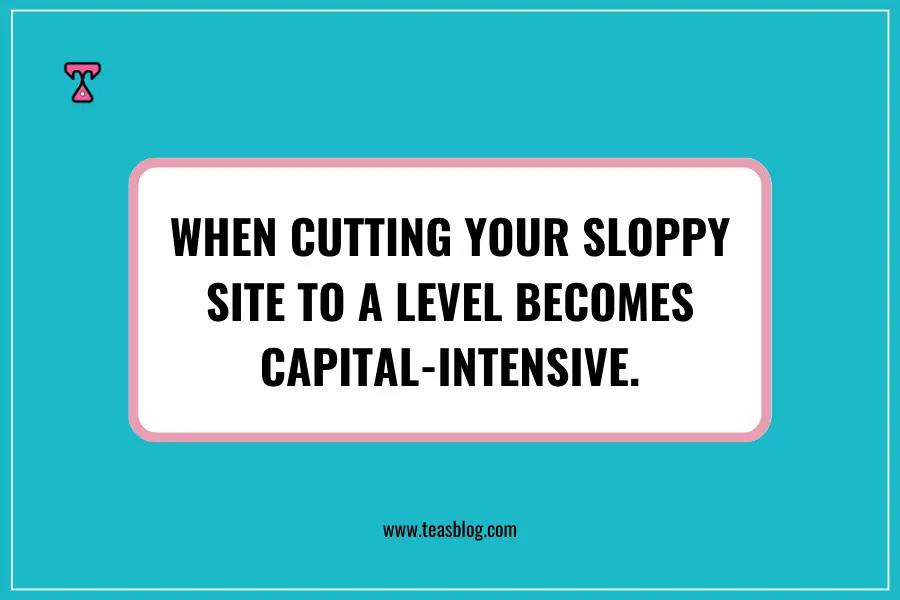Cutting your sloppy site to a flat level can become capital-intensive.
In 2015, a client spent N15,000,000 (Fifteen million naira) to cut and level a proposed site.
We have not started the foundation and 15M is gone.
The cut was approximately 3 metres in height.
This client felt that it was easier to construct on the site with no slope, but the truth is no site is flat.
Read also Tired of Tripping Over Wires? False Floors can Help!
Talk about the natural land slope and water surface run-off. How will water flow out on such a site?
Designs may come with “flat” elevation, but during construction, there is always that difference between the earth’s surface and the building on all sides.
Also, this tampers with the stability of the earth below the building. There is a natural compartment that already exists on the earth’s surface.
The stability of the exposed soil surface may be compromised and requires care to ensure a stable structure during construction.
Take care to engage the services of an Architect before doing anything on your site.
The use of varying levels in floor plans in a sloppy site.
One of my siblings doesn’t like staircases inside the building.
I’m not talking about staircases that take you from the ground floor to the first floor, I speak of interplay and changes in levels as you walk across a whole floor; say, the Ground floor.
This sibling of mine stumbles on the slightest change in floor level, even a ramp.
This one doesn’t look at the floor whilst walking and I always ask, “what if you step on a scorpion because you weren’t looking” and we quote the rest of that scripture.
But I love it!
Read The Basics of Estimating Your Building Materials.
Those little steps can help you create a mini basement for your mancave if you are looking for a space away from home (I’m speaking to the Men).
It’s that space where you entertain your clique visits without worrying about what the ladies (I mean your wives) are doing on the lawn sipping that ridiculous drink that they decorate with a slice of lemon and a baby umbrella.
You can have your private viewing centre there or a cinema or a mini-office or a workshop, undisturbed.
NO BEDS OR SHOWER SPACE.
Place a DO NOT DISTURB sign on the door when in use. Access can be from inside the house or outside.
Ladies can also create such private spaces for themselves.
Design Guidelines for Building on a Sloppy Site.
Designing buildings on sloped or hilly sites presents unique challenges and opportunities. Here are some guidelines to help you navigate the complexities of such projects:
Site Analysis and Planning
This includes taking geographical survey, determining the contours, soil testing to determine its stability or potentials of having erosion and environmental impact assessment to determine significant trees, natural features, or rock formations that should not be removed.
Design Strategies
In taking into consideration the slope on your site, consider terracing (multi-level) adjusted to meet the earth wherever possible. You can also use stilt or pier foundation to elevate your building above the slope or use retaining walls to stabilize the slope to create usable spaces.
It is important to keep in mind the drainage systems around your building to take advantage of the slope and prevent erosion. Take advantage of the slope to maximize views and natural light. Orient the building to capture the best visuals while considering solar gain and wind patterns.
Structural Considerations
The design foundations should suit the slope and soil conditions. In seismic-prone areas, ensure the structure is designed to withstand lateral forces. This includes using shear walls, bracing, and flexible connections. In material selection, blend your materials with the natural environment and provide durability against weathering and erosion.
Construction Techniques
If you can, avoid excavation. But if you cannot, minimize the amount of excavation to reduce site disturbance and maintain the natural stability of the slope. Implement erosion control measures during construction, such as silt fences, erosion control blankets, and revegetation.
Before construction begins, plan for access and logistics on the slope. This may require temporary roads, scaffolding, and safety measures for workers.
Sustainable Practices
Preserve existing vegetation as much as possible and incorporate native plants to stabilize the soil and reduce erosion. Consider installing energy efficient measures such as passive solar design, natural ventilation, and appropriate insulation.
Build rainwater harvesting and greywater recycling to manage water use sustainably.
Regulatory Compliance
Ensure that your use of the sloppy site complies with local building codes, zoning regulations, and environmental protection laws. Obtain necessary permits and approvals.
Endeavour to work with experienced architects, engineers, and contractors who have expertise in designing and building on sloped sites.
Contact us for design and construction.





